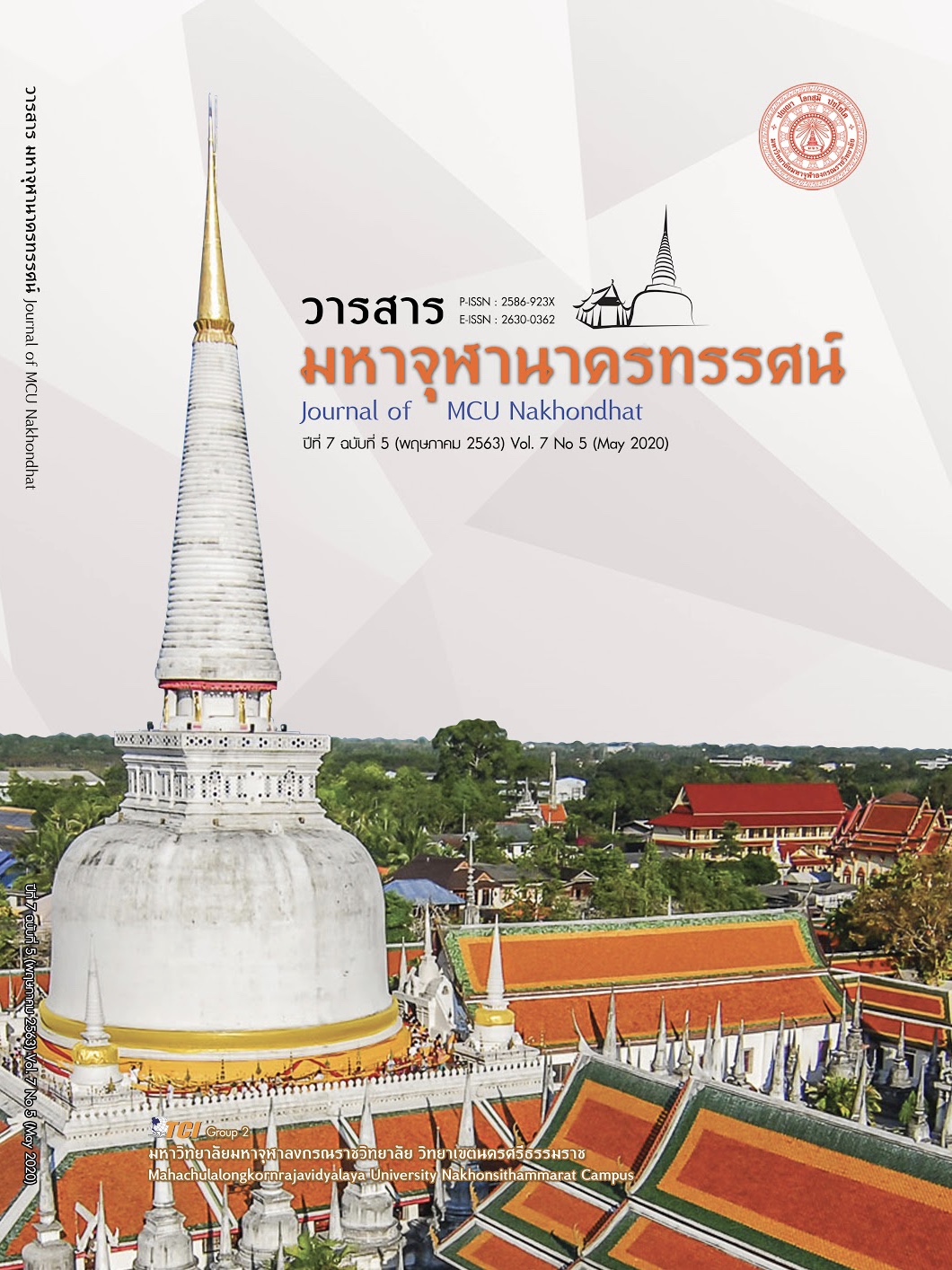AN APPLICATION OF BUDDHA’S TEACHING ON THE MINDFULNESS OF DEATH IN DAILY LIFE
Main Article Content
Abstract
The objectives of this article were: 1) to study the doctrine of mindfulness of death in the Buddhist scriptures, 2) to investigate the sample persons who employ mindfulness of death in Buddhism and 3) to apply Buddha’s teaching on the mindfulness of death in daily life. The study was conducted by qualitative research method focusing on document analysis (Documentary Research) from various sources to analyze their contents in accordance with the determined scope of the study.
The results are found that: 1) Findings revealed that mindfulness of death means the contemplation on death, the common phenomenon to all. One should have (Yonisomanasikāra) proper attention, consisting of consciousness, a sense of urgency and perception. Buddha’s teaching on the mindfulness of death focusing to remind person not to be negligent, spending the rest time very usefully, when death is at hand, one is able to support the mind with awareness and peace. 2) Those whose mind is not trained with mindfulness of death to feel sad, gloomy and are afraid of death. In contrast, those who practice mindfulness of death employ the death to help one have the higher spiritual development, one is not negligent, but performing wholesome deeds. When three signs occurring to those who are in death – theshold time. Those whose mind is engaged with wholesome deeds will be born in happy state as ther mind is engaged with bad deeds. For those who practice mindfulness of death, their practice can be perfection leading to attain enlightenment and final liberation next life, even though they cannot attain spiritual attainment within this life 3) An application of mindfulness of death in daily life according to Bhāvanā IV are physical dvelopment, moral development, emotional development and intellectual development. The value of mindfulness of death practice in the present life can be based kind of benefits; 3.1) benefit for oneself in terms of carefull in life, performing wholesome deeds, leading to nirvava next life, 3.2) others’ benefits on the way to help those who are about to die, inspire others by using death to develop spituality to the high level and to be good friend, helping those who are sorrowful due to departure of the beloved ones, 3.3) benefit to both, social benefit by fully performing one duty and resulting in peaceful society due to non-violence ang they are worth to be remembered.
Article Details
References
พระธรรมกิตติวงศ์ (ทองดี สุรเตโช). (2550). พจนานุกรมเพื่อการศึกษาพุทธศาสน์ ชุด ศัพท์วิเคราะห์. กรุงเทพมหานคร: โรงพิมพ์เลี่ยงเชียง.
พระธรรมธีราชมหามุนี (โชดก ญาณสิทฺธิเถร). (2542). หลักปฏิบัติสมถะและวิปัสสนากรรมฐาน. กรุงเทพมหานคร: โรงพิมพ์มหาจุฬาลงกรณราชวิทยาลัย.
พระพรหมคุณาภรณ์ (ป.อ. ปยุตฺโต). (2550). คู่มือชีวิต. (พิมพ์ครั้งที่ 14). กรุงเทพมหานคร: บริษัท พิมพ์สวย จำกัด.
. (2552). พุทธธรรม ฉบับปรับปรุงและขยายความ. (พิมพ์ครั้งที่ 11). กรุงเทพมหานคร: โรงพิมพ์มหาจุฬาลงกรณราชวิทยาลัย.
พระพุทธโฆสเถระ. (2548). คัมภีร์วิสุทธิมรรค แปลและเรียบเรียงโดย สมเด็จพระพุฒาจารย์ (อาจ อาสภมหาเถร). (พิมพ์ครั้งที่ 6). กรุงเทพมหานคร: ธนาเพรส จำกัด.
พระไพศาล วิสาโล. (2560). ระลึกถึงความตายสบายนัก การเจริญมรณสติในชีวิตประจำวัน. (พิมพ์ครั้งที่ 23). กรุงเทพมหานคร: ห้างหุ้นส่วนสามลดา.
พระมหาโพธิวงศาจารย์ (สุรเตโช). (2561). ธรรมสารเทศนา เล่ม 3. นครปฐม: รุ่งศิลป์การพิมพ์.
พระอุปติสสเถระ. (2560). วิมุติมรรค. แปลโดย พระพรหมบัณฑิต (ประยูร ธมฺมจิตฺโต) และคณะ. (พิมพ์ครั้งที่ 2). กรุงเทพมหานคร: โรงพิมพ์มหาจุฬาลงกรณราชวิทยาลัย.
มหาจุฬาลงกรณราชวิทยาลัย. (2539). พระไตรปิฎกภาษาไทย ฉบับมหาจุฬาลงกรณราชวิทยาลัย. กรุงเทพมหานคร: โรงพิมพ์มหาจุฬาลงกรณราชวิทยาลัย.
มหามกุฏราชวิทยาลัย. (2500). พระไตรปิฎกพร้อมอรรถกถาแปล ชุด 91 เล่ม. กรุงเทพมหานคร: โรงพิมพ์มหามกุฏราชวิทยาลัย.
สมเด็จพระญาณสังวร (สุวฑฺฒโน). (2551). อนุสสติและสติปัฏฐาน. (พิมพ์ครั้งที่ 5). นครปฐม: โรงพิมพ์มหามกุฏราชวิทยาลัย.


